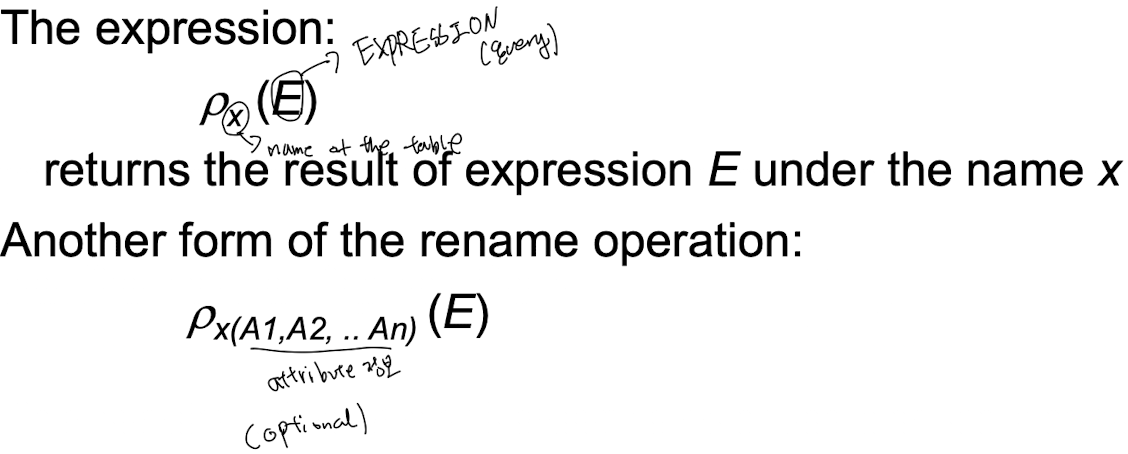03. Relation Algebra
Relation Algebra
Employees
| EmpID | Name | Age | DeptID |
|---|---|---|---|
| 1 | Alice | 30 | D1 |
| 2 | Bob | 25 | D2 |
| 3 | Charlie | 35 | D1 |
Departments
| DeptID | DeptName | Location |
|---|---|---|
| D1 | HR | New York |
| D2 | IT | San Francisco |
Relational Algebra Operations
1. Selection (σ) (Duplicated Data should be removed)
Select tuples that satisfy a condition.
Example: Select employees older than 30.
Expression: σAge > 30(Employees)
Result:
| EmpID | Name | Age | DeptID |
|---|---|---|---|
| 3 | Charlie | 35 | D1 |
2. Projection (π) (Duplicated Data should be removed)
Extract specific columns (attributes) from a relation.
Example: Project only the Name and Age attributes.
Expression: πName, Age(Employees)
Result:
| Name | Age |
|---|---|
| Alice | 30 |
| Bob | 25 |
| Charlie | 35 |
3. Union (∪)
Combine tuples from two union-compatible relations.
First, form two subsets of Employees:
- R1: Employees in department D1
- R1 = σDeptID = ‘D1’(Employees)
- R1 Result:
| EmpID | Name | Age | DeptID |
|---|---|---|---|
| 1 | Alice | 30 | D1 |
| 3 | Charlie | 35 | D1 |
- R2: Employees younger than 30
- R2 = σAge < 30(Employees)
- R2 Result:
| EmpID | Name | Age | DeptID |
|---|---|---|---|
| 2 | Bob | 25 | D2 |
Union Expression: R1 ∪ R2 Result:
| EmpID | Name | Age | DeptID |
|---|---|---|---|
| 1 | Alice | 30 | D1 |
| 3 | Charlie | 35 | D1 |
| 2 | Bob | 25 | D2 |
4. Set Difference (−)
Return tuples in one relation that are not in the other.
Example: Employees in D1 that are not younger than 30 (using the same subsets).
Expression: R1 − R2
Result:
| EmpID | Name | Age | DeptID |
|---|---|---|---|
| 1 | Alice | 30 | D1 |
| 3 | Charlie | 35 | D1 |
5. Set Intersection (∩)
Return tuples common to both relations.
Example: With our chosen subsets, there is no common tuple since no employee is both in D1 and younger than 30.
Expression: R1 ∩ R2
Result:
Empty relation
(If overlapping conditions were chosen, common tuples would be returned.)
6. Cartesian Product (×)
Combine every tuple of one relation with every tuple of another.
Expression: Employees × Departments
Result:
This produces 3 × 2 = 6 tuples. For example, one of the tuples is:
—
7. Natural Join (⨝)
Combine tuples from two relations based on common attribute(s).
Expression: Employees ⨝ Departments
Result:
The join is done on the common attribute DeptID. The result is:
| EmpID | Name | Age | DeptID | DeptName | Location |
|---|---|---|---|---|---|
| 1 | Alice | 30 | D1 | HR | New York |
| 3 | Charlie | 35 | D1 | HR | New York |
| 2 | Bob | 25 | D2 | IT | San Francisco |
8. Rename (ρ)
Change the name of a relation or its attributes.  Example: Rename Employees to Emp and change attribute DeptID to Department.
Example: Rename Employees to Emp and change attribute DeptID to Department.
Expression: ρEmp(EID, Name, Age, Department)(Employees)
Result:
The resulting relation Emp has attributes renamed as specified:
| EID | Name | Age | Department |
|---|---|---|---|
| 1 | Alice | 30 | D1 |
| 2 | Bob | 25 | D2 |
| 3 | Charlie | 35 | D1 |
